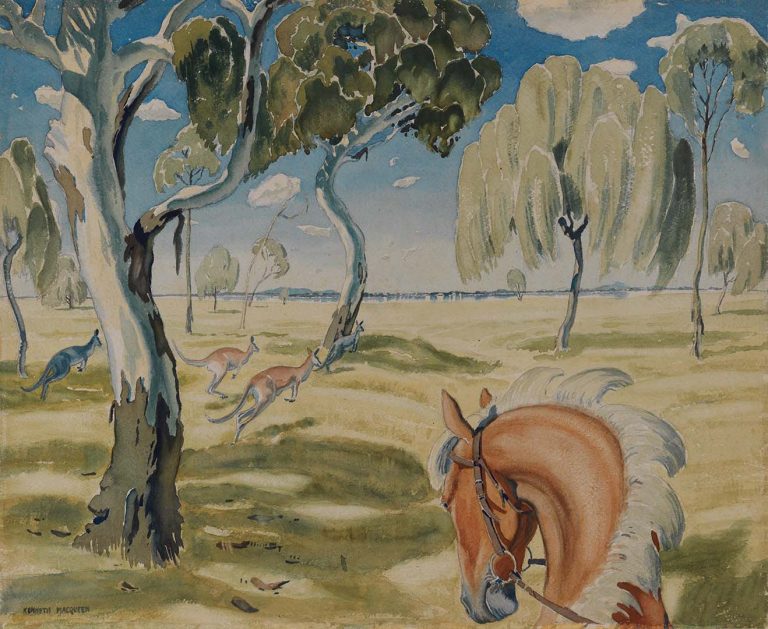We acknowledge the Traditional Owners of the land on which the Queensland Art Gallery | Gallery of Modern Art stands and recognise the creative contribution First Australians make to the art and culture of this country.

Kenneth Macqueen / Australia 1897–1960 / Morning ride c.1946 / Watercolour over pencil / 40.9 x 50cm / Purchased 2006. Queensland Art Gallery Foundation / Collection: Queensland Art Gallery | Gallery of Modern Art / © Kenneth Macqueen Estate
Kenneth MacqueenMorning ride c.1946
Not Currently on Display
Like many artists of his generation, Kenneth Macqueen was proudly patriotic. He sought to present a distinctly Australian vision of the land through his watercolours, honing in on characteristics specific to the Darling Downs to underline regional difference. In the mid 1940s, Macqueen completed a number of watercolours featuring kangaroos and eucalypts. These works have a quality that compares to the poster art of the period and celebrate Australia’s rural landscape.
In Morning ride c.1946, a group of kangaroos has been disturbed by a farmer and his horse, an interloper among the native fauna. Macqueen was acutely aware of the imposition of introduced species on the landscape:
About the ancient and massive ironbarks there is an aura calling for reverence . . . A solitude, unbroken save for the wild creatures feeding on them and about them, together with the newcomers — the cattle — who sharpen their horns on the sand-bars and bellow in foreign tongue beneath the arched limbs.1
At first glance, the watercolour appears to document Macqueen’s own farming life. The silhouette in the lower-right corner of the composition is, however, more likely his brother Jack’s — Jack was the horseman, while Macqueen preferred to deal with the farm machinery.
Endnotes:
1. Kenneth Macqueen, Adventure in Watercolour: An artist’s story, Legend Press, Sydney, 1948, p.2
Born in Ballarat, Victoria, in 1897, Kenneth Macqueen began to take a serious interest in watercolour painting as a 10-year-old, after watching a young friend use the medium. In 1909, Macqueen’s family moved to Sydney, where he received professional tuition in drawing from a commercial artist, Mr Beecroft.
In 1916, Macqueen enlisted with the Australian Imperial Force and was sent to France where he served with the 12th Army Brigade, Australian Field Artillery. He continued to paint, producing small watercolours in the field, and he pursued his art studies through a London-based correspondence course.
Macqueen returned to Australia in 1919 and, in 1922, he and his brother Jack settled on a property at Mount Emlyn, near Millmerran on Queensland’s Darling Downs. This area and the nearby coast provided his main subject matter from this time. He maintained a national profile, exhibiting regularly in Sydney and in other state capitals. His version of Modernism brought a fresh approach to the genre of landscape painting. His work was included in the exhibition ‘Art of Australia: 1788–1941’, which travelled to the United States and Canada in 1941. His watercolour Cabbage gums and cypress pines c.1940 was subsequently acquired by the Metropolitan Museum of Art, New York.